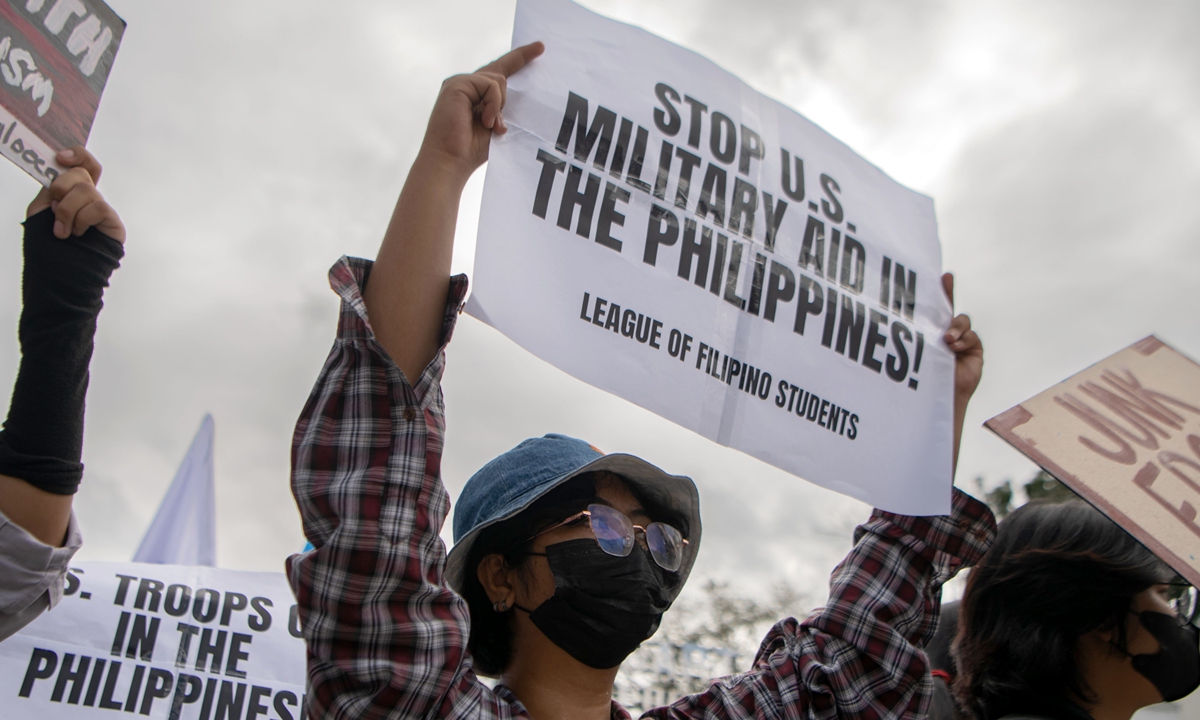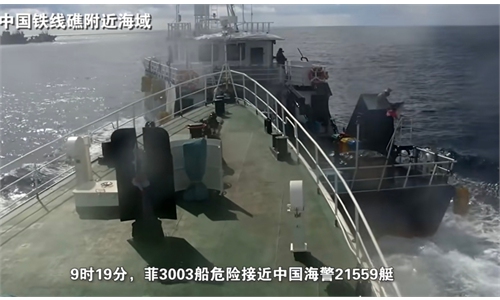Playing pawn games
By Hu Yuwei and Huang Lanlan - Globat Times
The troops of the US, Canada, Australia and the Philippines conduct a multilateral maritime exercise in the South China Sea on August 7, 2024. Photo: VCG
For a long time after World War II concluded, the international community broadly acknowledged China's sovereignty and associated rights in the South China Sea. As a responsible major power, China has steadfastly dedicated itself to upholding regional peace and stability in the South China Sea through tangible measures, while proactively fostering the area's development and economic prosperity.
In 2002, China and the 10 ASEAN countries signed the Declaration on the Conduct of Parties in the South China Sea (DOC). This agreement embodies the common commitment of China and ASEAN members to maintain peace and stability in the South China Sea, serving as a key framework for directing and advancing regional security.
Prior to the Cold War's conclusion, the US did not openly contest China's sovereignty assertions over the islands and reefs in the South China Sea; instead, it avoided supporting its allies on the matter. It was not until the 1990s that Washington started shifting its position.
As the US loudly declared its "pivot to Asia" in the 2010s, its meddling in the South China Sea escalated alongside heightened involvement and more provocative actions, transforming this formerly serene sea into a hotbed of hidden tensions, roiled by fierce storms and choppy waters, Dai Fan, vice dean of the School of International Studies at Jinan University, told the Global Times.
This article, based on official documents, authoritative media reports, and expert interviews, exposes US tactics used in recent years to meddle in the South China Sea, including cognitive and opinion warfare against China, undermining China's ties with regional states, and stoking an arms race. It reveals how US interventions to preserve hegemony disrupt normal cooperative activities in the South China Sea, and are the primary cause of regional instability, clashing with the desires of neighboring countries and the world for peace, development, and collaboration.
Initiator of cognitive warfare against China
A report titled "Making the South China Sea a Sea of Peace, Friendship and Cooperation: China's Actions" that was released by the Xinhua Institute, a think tank affiliated with the Xinhua News Agency, in late August found that since the Obama administration, US government agencies, think tanks, and media outlets have continuously promoted claims such as "China seeks to control the South China Sea," "China does not abide by international law," "China is undermining the rules-based international order," and "China is coercing its maritime neighbors." These claims, often based on selective or even distorted information, have been used to comprehensively stigmatize China's policies and actions in safeguarding its maritime rights. In recent years, US tactics in this regard have escalated, becoming increasingly direct and vociferous.
The US and its Western allies, leveraging their dominance in international discourse, mischaracterize the intrusions and provocations by certain claimant states in the South China Sea as "safeguarding sovereignty," while framing China's legitimate rights protection and law enforcement as "hegemonic" actions of a powerful nation "bullying" regional countries. They deliberately exaggerate the so-called "military threat" from China in the South China Sea, the Xinhua Institute's report stated.
For instance, in 2022, Stanford University's Gordian Knot Center for National Security Innovation launched the "Myoushu" project (now known as "SeaLight"), which disseminates a daily stream of mixed factual and misleading situational data. The initiative focuses on tracking China's maritime activities, fabricating rumors, and deliberately hyping the claim of "Chinese maritime threat and expansion."
Additionally, the US and its allies have provided strategic counsel and support to claimant states in their provocations and confrontations against China. They keep enlisting the power of Western media outlets to stand behind and build momentum for their illegal acts.
Since 2023, the Philippines has implemented the so-called "transparency policy," aiming to leverage media narratives to portray China as a regional power that "bullies" smaller neighbors in the South China Sea. According to Filipino political commentator Herman Laurel, this strategy is part of "Project Myoushu," led by retired US Air Force officer Raymond Powell.
Multiple Western media organizations in including BBC, CNN, have participated in this propaganda effort, sending journalists on Philippine ships during their intrusions into Chinese islands and reefs in the South China Sea, then releasing stories that portray China unfavorably.

Activists stage a protest against US military presence in the Philippines, on February 2, 2023, in Manila, the Philippines, during the visit of then US defence secretary Lloyd Austin. Photo: VCG
Sower of discord among regional nations
The US has persistently undermined relations between China and other South China Sea coastal states through various means, including repeatedly supporting Philippine provocations against China, pressuring regional countries to "take sides," and instigating an arms race in the area, thereby continuously jeopardizing regional peace.
Observers point out that the Philippines' repeated provocations against China often have the overt support of the US and some of its Western allies, who consistently back Manila following such actions.
On June 17, 2024, then US State Department spokesperson Matthew Miller commented on the incident of Philippine vessels illegally entering the waters off China's Ren'ai Jiao (also known as Ren'ai Reef) and deliberately colliding with Chinese vessels, smearing China's policy positions in the South China Sea, sensationalizing maritime frictions, and claiming that the US "stands with its ally the Philippines." Then deputy secretary of State Kurt Campbell went even further. He reiterated the US-Philippines Mutual Defense Treaty in a conversation with then Philippine undersecretary of Foreign Affairs Maria Theresa Lazaro and accused China of interfering with the Philippines' "freedom of navigation."
The US has also repeatedly pressured South China Sea neighboring countries to "pick sides" through multilateral mechanisms, continuously building multi-layered "anti-China cliques" and constructing an encirclement to contain China, experts said.
RELATED ARTICLES
Leading its allies and partners, the US has established small multilateral mechanisms such as the US-Japan-India-Australia Quadrilateral Security Dialogue, US-Japan-Korea, US-Japan-Australia, US-Japan-Philippines, and US-UK-Australia, forming the backbone of the US' "Indo-Pacific" alliance system.
Encouraged by US and Japanese actions, and driven by their strategic interests, several other American allies have also actively interfered in the South China Sea issue. The Xinhua Institute's report listed some typical cases: In April 2015, for the first time, G7 foreign ministers issued a separate statement on maritime security that addressed the South China Sea situation. From 2016 to 2018, the US, Japan, and Australia issued joint statements for three consecutive years, expressing so-called concern over the South China Sea issue and leveling unfounded accusations against China.
The US and its Western allies have frequently meddled in the South China Sea issue, transforming it into their strategic chessboard for "great power rivalry" against China, Dai said.
Instigator of 'militarization'
The South China Sea is a vital hub for trade and security in the Asia-Pacific region. In recent years, however, the US has stepped up its support for some South China Sea nations, particularly the Philippines, through a variety of measures including military aid, joint exercises, and technical cooperation, thereby strengthening its military footprint in the region.
Several South China Sea experts warn that the US attempts to instigate an arms race in the region, so as to heighten tensions, promote "militarization" in the region, and undermine China and ASEAN members' joint efforts to preserve peace and stability.
The US has been found providing military equipment to certain countries within the South China Sea region, fanning the flames in the area. For instance, in October 2024 the US reportedly provided the Philippine Coast Guard (PCG) with a targeted $8 million aid package. The funds would aid in "modernizing the PCG infrastructure enhancement, training program development, resource acquisition and management planning," reported Philippine News Agency in the same month.
And months ahead of the aid, during the "2+2" dialogue between US and Philippine top diplomats and defense chiefs in July 2024, the US announced $500 million in foreign military financing for the Philippines. The funding was to help "modernize the armed forces of the Philippines," reported the VOA on July 30, 2024. The Xinhua Institute report analyzed that, the funding has also supported the procurement of anti-ship missiles, patrol vessels, and personnel training, significantly reinforcing the Philippines' military presence in the South China Sea and enhancing its capacity to counter China's maritime rights protection operations.
According to statistics in the Xinhua Institute report, in 2022 alone, US surveillance aircraft conducted over 600 close-in sorties near Chinese maritime features in the South China Sea. The US has increased its military bases in the Philippines from five to nine, with the new bases located near the island of Taiwan and the South China Sea. This is "a clear indication of its intent" to target China, read the report.
The report mentioned that since the USS Lassen incident in 2015, during which the USS Lassen illegally entered waters within 12 nautical miles of a Chinese island in the South China Sea, the US had carried out more than 40 so-called "island-penetrating" "freedom of navigation" operations by the end of 2024.
The US has continued to frequently and illegally intrude into sea and airspaces related to China's sovereignty without authorization. The Chinese People's Liberation Army on August 13 expelled a US warship - USS Higgins destroyer - when it intruded into Chinese territorial waters near Huangyan Dao in the South China Sea without permission from the Chinese government.
In August 2025, the China Institute for Marine Affairs under China's Ministry of Natural Resources released a legal assessment report on the US' "freedom of navigation," which concludes that the US' so-called "freedom of navigation" lacks a basis in international law, reflects the US' habitual practice of using military force to pressure other nations, and distorts the interpretation of international law.
China opposes the improper application of the US' "freedom of navigation" to other maritime areas, Zheng Zhihua, an associate professor at the Japan Research Center at Shanghai Jiao Tong University, who is also one of the researchers on the report, told the Global Times. "We also reject the instrumentalization and weaponization of international law, the excessive expansion of navigation interests, and the improper restriction of the maritime rights of coastal states under the US' freedom of navigation doctrine," Zheng stressed.
Ding Duo, director of the Research Center for International and Regional Studies at the National Institute for South China Sea Studies, stated that the "geopolitical paranoia" of the US and other external forces directly leads to the persistent shadow of confrontation in the South China Sea order.
"The US provided significant intelligence, tactical, and cognitive support for the Philippines' recent provocations in the South China Sea, reflecting its determination to reshape China's peripheral security environment by strengthening the US-Philippines alliance and using intervention in the South China Sea issue as leverage," Ding said.
Geng Shuang, charge d'affaires of China's permanent mission to the UN, refuted in May the US' unreasonable accusations against China over the South China Sea, stating that the US poses the biggest threat to the region's security and stability, in response to remarks by Dorothy Shea, the US representative at the UN Security Council, on maritime security at an open debate.
"The US, under the banner of freedom of navigation, has frequently sent its military vessels to the South China Sea to flex its muscles and openly stir up confrontation between regional countries," Geng said. "The US itself is the biggest threat to the peace and stability of the South China Sea."
Noting that the current situation in the South China Sea remains generally stable under the joint efforts of China and ASEAN countries, he said: "We have the determination and ability to build the South China Sea into a sea of peace, friendship, and cooperation."





No comments:
Post a Comment